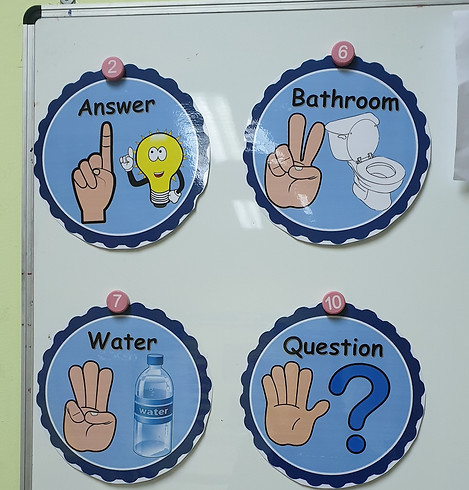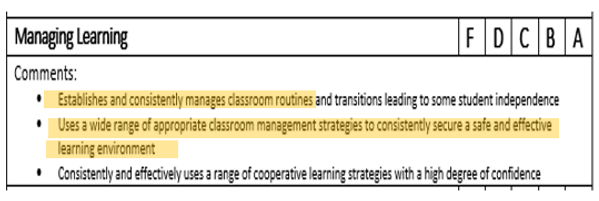Managing Learning
Page overview:
This page demonstrates my use of behavior manage strategies to manage learning and students' behavior in the classroom.
Definition
Managing learning is defined as a way to establish a respectful, positive, nurturing learning environment (Nessipbayeva, 2012). In order to achieve such a classroom, teachers learn to apply various strategies in the classroom and train students to follow instructions.
Professional Development Plan (PDP) Goal
Voice-level chart
Each level on the chart indicates a specific voice level, and when the light above it is on, it means students must comply. The aim was to increase students’ awareness of what voice-level they should be using during different activities. This was a strategy I used for my PDP goal, which was to manage students' voice levels in the classroom as a way to have better classroom management.
Rationale
Guiding students in letting them know what the appropriate levels are will bring upon long-term benefits. Once students have gotten accustomed to the appropriate levels of voice, the teacher will not have to shout over their voices to quiet them down (Roffey, 2018). When the teacher acts in a calm manner, students follow suit.
Hand Signals

The hand signals serve as a method to eliminate excessive talking through an implicit behavior management technique of having students provide the teacher with their requests by making numbers with their fingers.
Rationale
Making use of signals has a good effect on students' behavior, and it helps to deal with disruption in the classroom (Roffey, 2018). Using signals is also indicative of mutual understanding through communication between the teacher and student.
Mentoring College Teacher (MCT) Feedback

Based on my MCT's feedback, I managed to make use of various classroom management strategies. This means I am closer to achieving this goal.
Positive Reinforcement

This strategy worked as a reward system in which students received money in their individual envelopes when they displayed good behavior, and had money removed if they misbehaved.
Rationale
Stronge, Tucker, and Hindman (2004) explain that management mustn't be used to control students' behavior, but rather to manage it in a positive manner. In other words, building a positive classroom environment will inevitably lead to good behavior (Stronge & Tucker & Hindman, 2004).
Mentoring School Teacher (MST) Feedback

My MST commented on my use of positive strategies to promote a positive, effective learning environment. Rather than focusing on scolding, or punishing students, alternative strategies are also successful in securing a safe environment that encourages good behavior.
References:
Nessipbayeva, O. (2012). The competencies of the modern teacher.
Roffey, S. (2018). The secondary behaviour cookbook : strategies at your
fingertips.
Stronge, J. H., Tucker, P. D., & Hindman, J. L. (2004). Handbook for qualities
of effective teachers. Retrieved from http://www.ascd.org/publications/
books/104135/chapters/Classroom-Management-and-Organization.aspx

